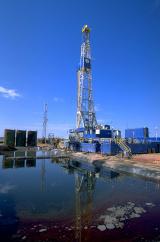Final Report: Oil and Gas Extraction Wastewater Management
EPA has completed a stakeholder engagement effort that sought input on how the Agency, states, tribes and stakeholders regulate and manage wastewater from the oil and gas industry.
Background
Large volumes of wastewater are generated in the oil and gas industry, and projections show that these volumes will only increase. Currently the majority of this wastewater is managed by disposing of it using a practice known as underground injection, where that water can no longer be accessed or used. The limits of injection are evident in some areas, and new approaches are becoming necessary. Some states and stakeholders are asking whether it makes sense to continue to waste this water, particularly in water scarce areas of the country, and what steps would be necessary to treat and renew it for other purposes.
EPA's Engagement Effort
The focus of the Agency’s effort was to engage with states, tribes and stakeholders to consider available approaches to manage wastewater from both conventional and unconventional oil and gas extraction at onshore facilities. EPA’s effort considered questions such as how existing federal approaches to produced water![]() Produced waterThe fluid brought up from the hydrocarbon-bearing strata during the extraction of oil and gas, and includes, where present, formation water, injection water, and any chemicals added downhole or during the oil/water separation process. [40 CFR 435.33 (v)] management under the Clean Water Act can interact more effectively with state and tribal regulations, requirements, or policy needs, and whether potential federal regulations that may allow for broader discharge of treated produced water to surface waters are supported. EPA is particularly interested in working with its regulatory partners at the state level, who are at the forefront of the changing industry, and often manage complex water allocation programs under state law.
Produced waterThe fluid brought up from the hydrocarbon-bearing strata during the extraction of oil and gas, and includes, where present, formation water, injection water, and any chemicals added downhole or during the oil/water separation process. [40 CFR 435.33 (v)] management under the Clean Water Act can interact more effectively with state and tribal regulations, requirements, or policy needs, and whether potential federal regulations that may allow for broader discharge of treated produced water to surface waters are supported. EPA is particularly interested in working with its regulatory partners at the state level, who are at the forefront of the changing industry, and often manage complex water allocation programs under state law.
Engagement Report
EPA released a draft report in May 2019 that described what it heard during its engagement for this study. EPA accepted public input on the draft report and, after considering this input, has published a final report.
The Agency is still determining what, if any, next steps should be taken regarding produced water management under the Clean Water Act.
Related Information
- Existing Effluent Guidelines:
- Oil and Gas Extraction Category (40 CFR Part 435)
- Centralized Waste Treatment Category (40 CFR Part 437)
- EPA Presentation for October 9, 2018 Public Meeting - Oil and Gas Study
- Statements submitted to EPA at regulations.gov (Docket ID: EPA–HQ–OW–2018–0618)
Additional Information
For additional information on Oil and Gas Effluent Guidelines, please contact Jesse Pritts (pritts.jesse@epa.gov) or 202-566-1038.

